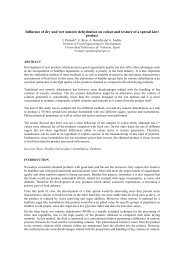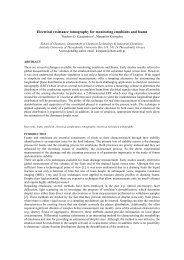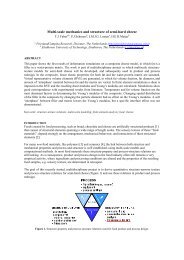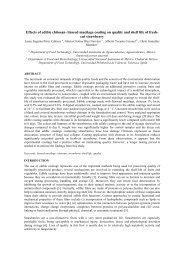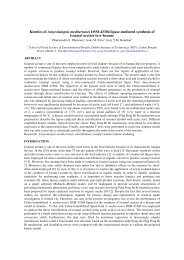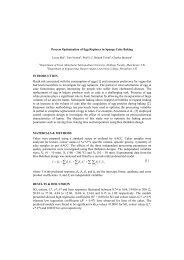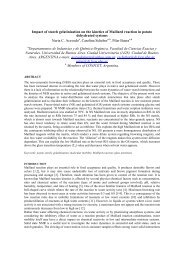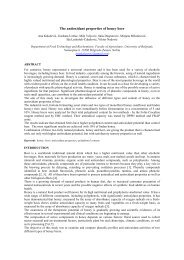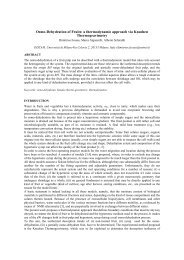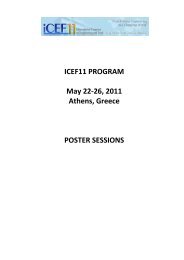Removability of bacterial spores from solid surfaces during cleaning
Removability of bacterial spores from solid surfaces during cleaning
Removability of bacterial spores from solid surfaces during cleaning
Create successful ePaper yourself
Turn your PDF publications into a flip-book with our unique Google optimized e-Paper software.
<strong>Removability</strong> <strong>of</strong> <strong>bacterial</strong> <strong>spores</strong> <strong>from</strong> <strong>solid</strong> <strong>surfaces</strong> <strong>during</strong> <strong>cleaning</strong><br />
Takaharu Sakiyama, Yusuke Nanasaki, Tomoaki Hagiwara, Hisahiko Watanabe<br />
Tokyo University <strong>of</strong> Marine Science and Technology, Tokyo 108-8477, Japan (sakiyama@kaiyodai.ac.jp)<br />
ABSTRACT<br />
<strong>Removability</strong> <strong>of</strong> Bacillus subtilis <strong>spores</strong> directly adhering to <strong>solid</strong> <strong>surfaces</strong> through water rinsing and alkali<br />
<strong>cleaning</strong> was studied. Spores were made adherent to coupons <strong>of</strong> stainless steel (SS) and polypropylene (PP)<br />
through deposition <strong>from</strong> suspension under humid and dry conditions, and subjected to rinsing in water or<br />
NaOH solution with shear force application. Experimental results demonstrated that drying significantly<br />
enhanced strength <strong>of</strong> the spore adhesion for both types <strong>of</strong> surface. No removal through water rinsing was<br />
observed for the <strong>spores</strong> adhering to <strong>surfaces</strong> exposed to dry environment. Even with 0.2% NaOH, they were<br />
hardly removed <strong>during</strong> 10 min treatment irrespective <strong>of</strong> temperature. Although 1% NaOH removed or<br />
inactivated most <strong>of</strong> <strong>spores</strong> on SS surface, a considerable number <strong>of</strong> <strong>spores</strong> were found to remain on PP<br />
surface. Thus enhanced alkali tolerance was indicated for <strong>spores</strong> adhering to <strong>surfaces</strong>, especially made <strong>of</strong> PP.<br />
We also found that removal <strong>of</strong> the adherent <strong>spores</strong> <strong>during</strong> alkali <strong>cleaning</strong> was apparently describable by the<br />
first order kinetics.<br />
Keywords: alkali <strong>cleaning</strong>; Bacillus subtilis; stainless steel; polypropylene<br />
INTRODUCTION<br />
Bacterial <strong>spores</strong> are <strong>of</strong>ten a concern <strong>of</strong> food manufacturers because they are more resistant to such lethal<br />
factors as heat and sanitizing agents than vegetative cells. For keeping a hygienic process, it is important to<br />
avoid the adhesion <strong>of</strong> <strong>bacterial</strong> <strong>spores</strong> and to remove or inactivate any <strong>spores</strong> that do adhere. Thus<br />
information on adhesion and removal characteristics <strong>of</strong> <strong>bacterial</strong> <strong>spores</strong> on various types <strong>of</strong> food contact<br />
<strong>surfaces</strong> is desired for basic understanding.<br />
Objective <strong>of</strong> this study is to clarify behaviors <strong>of</strong> <strong>bacterial</strong> <strong>spores</strong> directly adhering to <strong>solid</strong> <strong>surfaces</strong> against<br />
rinsing and <strong>cleaning</strong>, using Bacillus subtilis <strong>spores</strong> as an example. We focused on the effect <strong>of</strong> presence <strong>of</strong><br />
water around the <strong>spores</strong> on their adhesive strength; Bacillus subtilis <strong>spores</strong> were made adherent through<br />
deposition by contacting their suspension with <strong>solid</strong> <strong>surfaces</strong> under humid and dry environments. Coupons <strong>of</strong><br />
stainless steel and polypropylene were used as substrate <strong>surfaces</strong> since they are major materials for food<br />
processing equipment and containers.<br />
MATERIALS & METHODS<br />
Bacillus subtilis NBRC3134 were inoculated onto Trypticase Soy Agar (TSA) (Becton, Dickinson and Co.,<br />
MD, USA) and incubated at 37˚C for 6 days. Spores grown on TSA were harvested and suspended in 1 ml <strong>of</strong><br />
sterile distilled water. The spore suspension was heated at 100˚C for 10 min to inactivate vegetative cells, and<br />
centrifuged at 8700×g for 30 s. After the supernatant was discarded, 1 ml <strong>of</strong> sterile water was added to the<br />
<strong>spores</strong>, and centrifuged again. This rinsing procedure was repeated two more times. Finally, the <strong>spores</strong> thus<br />
collected were suspended in sterile distilled water usually at 2000–3000 CFU/ml.<br />
The spore suspension (100 µl) was inoculated onto the surface <strong>of</strong> each test coupon (50×50 mm 2 ) made <strong>of</strong><br />
type 304 stainless steel (SS) and polypropylene (PP), and spread as uniformly as possible. The coupons<br />
loaded with spore suspension were left in a clean bench for 0–60 min. The amount <strong>of</strong> water on the coupons<br />
decreased with time due to evaporation, and almost all <strong>of</strong> the water disappeared after 60 min. In some<br />
experiments, the coupons loaded with spore suspension were left in vessels covered with wet tissue paper<br />
under a sterile condition for 0–60 min. In such a humid condition, water remained on the coupons still after<br />
60 min. The artificially contaminated coupons thus obtained were soaked in sterile distilled water for 10 min<br />
to remove loosely adherent <strong>spores</strong>. Then the number <strong>of</strong> <strong>spores</strong> adhering to each coupon was determined by<br />
counting colonies grown through 20 h incubation at 37˚C in Modified Shapton and Hindes Agar (MSHA) [1]<br />
covering the coupon.
The coupons artificially contaminated with 60 min exposure to dry or humid environment as described above<br />
were soaked in a rinsing medium to start rinsing experiments. Sterile distilled water or NaOH solution was<br />
used as the rinsing medium. Throughout the rinsing experiment, shear force was continuously applied by<br />
agitation with a rotating impeller placed with a fixed topological arrangement. The number <strong>of</strong> <strong>spores</strong><br />
remaining on the coupon was determined as described above.<br />
Lethality <strong>of</strong> alkaline solutions was also studied for comparison. Spores collected by centrifugation (8700×g<br />
for 30 s) were suspended in 1.0 ml <strong>of</strong> NaOH solution, and incubated at 25˚C or 75˚C for 10 min. The alkaline<br />
suspension was then neutralized by adding aliquot <strong>of</strong> 10% acetic acid, and adequately diluted. The number <strong>of</strong><br />
viable <strong>spores</strong> was determined by colony count on MSHA.<br />
RESULTS & DISCUSSION<br />
Adhesion <strong>of</strong> <strong>spores</strong> to <strong>solid</strong> <strong>surfaces</strong><br />
Figure 1 shows numbers <strong>of</strong> spore adhering to each type <strong>of</strong> test coupon exposed to dry and humid<br />
environments for 0–60 min. For SS surface exposed to the humid environment, the number <strong>of</strong> adherent<br />
<strong>spores</strong> increased with time initially for about 30 min. However the increase ceased thereafter, resulting in<br />
approximately 50 CFU per coupon as the final number <strong>of</strong> adherent <strong>spores</strong>. For PP surface exposed to the<br />
humid environment, the number <strong>of</strong> adherent <strong>spores</strong> increased with time and finally reached around 100 CFU<br />
per coupon, the final number being significantly higher than that on SS surface (P
insing (hereafter referred to as residual fraction). The residual fraction <strong>of</strong> <strong>spores</strong> adhered under the humid<br />
environment was below 0.3 irrespective <strong>of</strong> rinsing temperature for the both types <strong>of</strong> surface. In contrast, the<br />
residual fraction <strong>of</strong> <strong>spores</strong> adhered under the dry environment was around one; no removal by water rinsing<br />
was suggested for the both types <strong>of</strong> surface irrespective <strong>of</strong> rinsing temperature. Thus exposure to the dry<br />
environment <strong>during</strong> adhesion, or removing water around <strong>spores</strong> by evaporation, not only increased the<br />
number <strong>of</strong> adherent spore but also made the spore adhesion firm enough to endure shear force applied in the<br />
water rinsing. These results also showed that rinsing temperature had little effect on the removability <strong>of</strong><br />
<strong>spores</strong> <strong>during</strong> water rinsing.<br />
Hydrophobic interaction has been suggested as responsible for a wide range <strong>of</strong> spore adhesion [2]. Thus, if<br />
the <strong>surfaces</strong> have portions <strong>of</strong> hydrophobic nature, <strong>spores</strong> can strongly interact with those portions upon<br />
removal <strong>of</strong> water molecules covered them. Such interaction induced by drying may be a major cause for no<br />
removal in water rinsing even with shear force application, though further study is necessary for clarification.<br />
Figure 2. Residual fraction <strong>of</strong> B. subtilis <strong>spores</strong> on SS and PP coupons after water rinsing.<br />
Each coupon was contaminated with spore suspension and exposed to humid or dry environment for 60 min prior to<br />
water rinsing conducted with agitation for 10 min at (a) 25˚C or (b) 75˚C. Bars show standard deviation (n=3).<br />
Effect <strong>of</strong> alkali treatment on residual fraction <strong>of</strong> <strong>spores</strong><br />
Contaminated SS and PP coupons exposed to dry environments for 60 min were subjected to alkali treatment<br />
in 0.2% or 1.0% NaOH with agitation. Table 1 shows residual fractions <strong>of</strong> B. subtilis <strong>spores</strong> after 10 min<br />
alkali treatment. Generally the residual fraction was lower at higher temperature and at higher NaOH<br />
concentration for both types <strong>of</strong> <strong>spores</strong>. In this case, the decrease in residual fraction may be not only due to<br />
removal but also due to inactivation <strong>of</strong> <strong>spores</strong> by alkali. Therefore survival <strong>of</strong> <strong>spores</strong> suspended in 0.2% or<br />
1.0% NaOH for 10 min was studied for comparison. The results are also shown in Table 1. After alkali<br />
treatment at 25˚C, the residual fraction <strong>of</strong> <strong>spores</strong> on both types <strong>of</strong> surface was significantly higher than the<br />
survival fraction in suspension. This indicates at least that <strong>spores</strong> adhering to SS and PP <strong>surfaces</strong> had a higher<br />
tolerance to alkali than <strong>spores</strong> in suspension. After alkali treatment at 75˚C, the residual fraction <strong>of</strong> <strong>spores</strong> on<br />
PP surface was much higher than the survival fraction in suspension, though that <strong>of</strong> <strong>spores</strong> on SS surface was<br />
similar to the survival fraction. Thus the <strong>spores</strong> adhering to PP surface had significantly high tolerance to<br />
alkali.<br />
In general, bacteria in bi<strong>of</strong>ilm are known to show higher tolerance to environmental stresses, including<br />
chemical ones, than planctonic cells [3–5]. Bacteria can be protected <strong>from</strong> chemical stresses by the bi<strong>of</strong>ilm<br />
surrounding them. In the case <strong>of</strong> this study, however, the <strong>spores</strong> were adherent to the <strong>surfaces</strong> without any<br />
protective substances to cover them. Although mechanism for enhanced alkali tolerance <strong>of</strong> adherent <strong>spores</strong> is<br />
unclear at present, hydroxyl ions might hardly reach the surface because <strong>of</strong> chemical characteristics <strong>of</strong><br />
<strong>surfaces</strong>.<br />
Furthermore, apparent removal kinetics <strong>during</strong> alkali <strong>cleaning</strong> was investigated. Figure 3 shows the change in<br />
residual fraction <strong>of</strong> B. subtilis <strong>spores</strong> on SS and PP coupons <strong>during</strong> alkali <strong>cleaning</strong> with 1% NaOH at 65°C.
Removal pr<strong>of</strong>iles <strong>of</strong> the adherent <strong>spores</strong> <strong>during</strong> 30 min alkali <strong>cleaning</strong> were found to follow the first order<br />
kinetics approximately. The <strong>spores</strong> on PP coupon gave lower rate constant than those on SS coupon.<br />
Table 1. Residual fractions <strong>of</strong> B. subtilis <strong>spores</strong> on SS and PP coupons A after 10 min alkali treatment with agitation at<br />
25˚C or 75˚C in comparison with survival fractions <strong>of</strong> <strong>spores</strong> suspended for 10 min in alkali solution.<br />
NaOH (%)<br />
Temperature Residual fraction <strong>of</strong> adherent spore<br />
(°C) on SS on PP<br />
Survival fraction <strong>of</strong><br />
suspended spore<br />
0.2 25 0.79 ± 0.07 a 0.98 ± 0.03 a 0.45 ± 0.12 b<br />
0.2 75 0.63 ± 0.02 a 0.87 ± 0.23 a 0.17 ± 0.05 b<br />
1.0 25 0.01 ± 0.01 b 0.72 ± 0.07 a 0.01 ± 0.01 b<br />
1.0 75 ND 0.34 ± 0.01 ND<br />
ND: viable <strong>spores</strong> not detected. A Each coupon was contaminated with spore suspension and<br />
exposed to dry environment for 60 min prior to alkali treatment. a,b Values, expressed as mean ±<br />
standard deviation, in the same row followed by different superscript letters differ significantly<br />
(P



